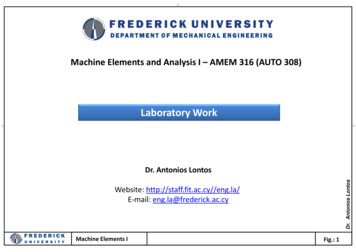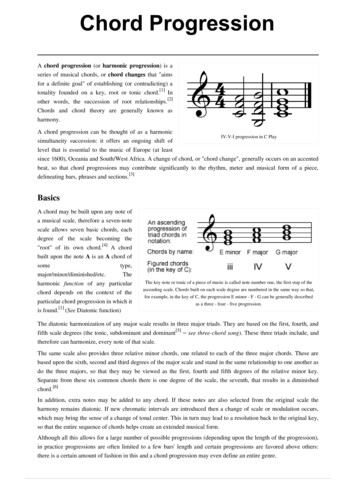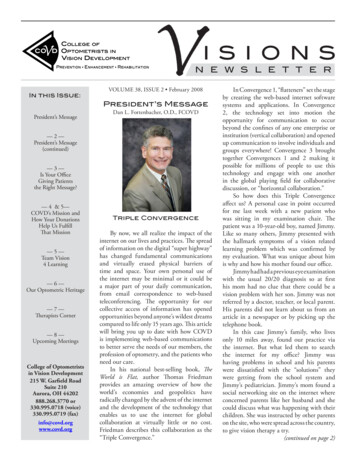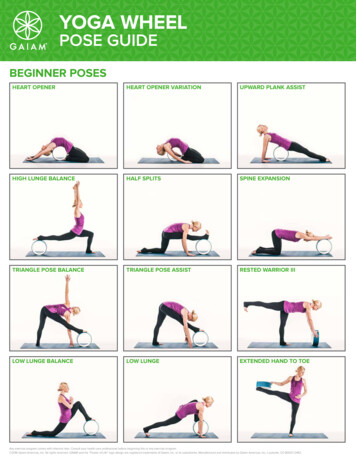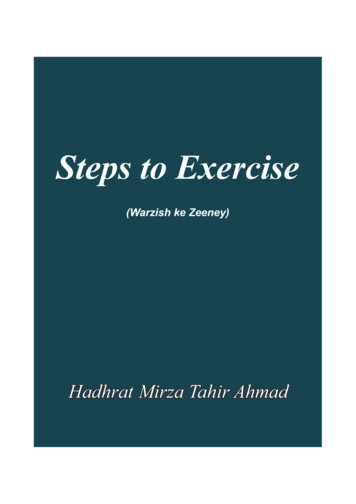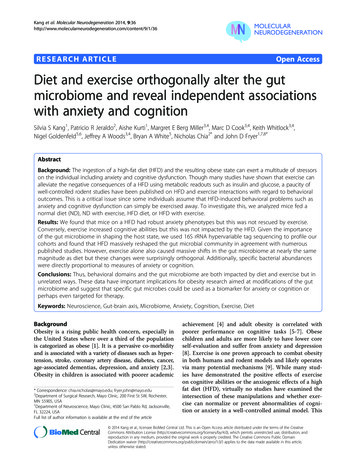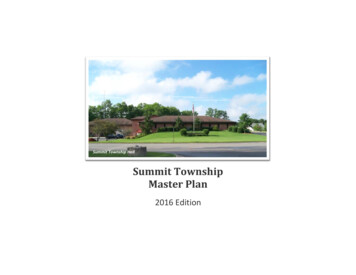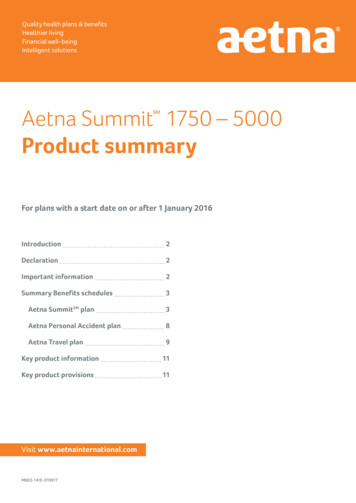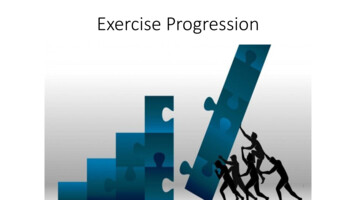
Transcription
Exercise Progression1
Exercise Progression An art, not a science Multifactorial and individualized Should be based on goals of the patient Needs to start with tolerable and non threateningmovement (SINSS)2
Current Situation PT has historically failed to provide sufficient stimulito achieve desired outcomes in individualsreturning to activity, especially sports Grindhem (2016) Quadriceps strength deficit prior to return to level 1sport was a significant predictor of knee re injury, with a3% reduced reinjury rate for every 1% increase instrength symmetry. Gokeler (2017) “Too often, the end phase of rehabilitation is notextensive or specific enough, thereby exposing patientsto specific training loads and characteristics that theycannot handle from a physical, physiological,neurocognitive and psychological perspective.”3
ActivityDemandsDuring MultiDirectionalTeam Sports:A SystematicReviewTaylor 2017 Soccer 90-minute match Athletes change activitybetween 500 and 3000x overthe course of competition(every 2-4 seconds) Should be able to perform(controlled setting) 10,000m of total distance30 sprint repetitions100 high intensity running reps300m of lateral movement
General Concepts Use pain as your guide Does contraction type matter? Isometric – concentric – eccentric Sometimes eccentrics first. Why? Sometimes isometrics first. Why? Contraction type may help pain modulation5
Contraction Type and Shoulder Pain Concentrics directly related to the area ofpathology usually mimic the aggravating factor ormovement Should likely be avoided early in the rehabilitationprocess Eccentrics have failed to show superioritycompared to other methods of loading for rotatorcuff and upper limb tendinopathy (Ortega-Castillo 2015,Spargoli 2019) Optimal dosage, frequency of treatment, and loadprogression needs to be further researched6
As outlined in this review, there is little evidence forisolating the eccentric component of a loadingbased regime (Couppe’ 2015) The basic mechanisms that are likely to influencetendon adaptations appear to be related mainly totendon load/strain magnitude and duration, andthere is no theoretical basis for greater tendonloads in eccentric exercises at a given force (bodyweight or external load) (Couppe’ 2015) There is a significant lack of evidence that confirmseccentric training having clear positive results inelbow and shoulder tendon injuries (Abat 2017)7
Contraction Type and Knee Pain Eccentric-Concentric squat-based physical therapyhas good evidence for use as an initial conservativetreatment of patellar pain (Everhart 2017) When comparing isolated actions, eccentrictraining shows better results than the application ofconcentric work. These benefits have been shownin patellar pain (Everhart 2017) Strengthening the hip and core resulted in earlierresolution of pain compared to knee alone(Ferber2018)8
Isometrics Likely to reduce patella tendon pain immediatelyfor at least 45 min postintervention The reduction in pain was paralleled by a reduction incortical inhibition, providing insight into potentialmechanisms (Rio 2015) Eccentric-concentric training combined withisometric contractions produced the largest effectin the reduction of pain and improvement offunction at the end of the treatment and at any ofthe follow-up time points (Stasinopolos 2017)9
Exercise-Induced Hypoalgesia A single bout of exercise influences the experienceof pain In healthy young adults, acute aerobic andisometric exercise temporarily reduces painsensitivity, a phenomenon termed exercise-inducedhypoalgesia (EIH)10
Final Thought on Contraction Type Probably the best thing to do is experiment with load(regardless of contraction type) and find the ‘entrypoint’ to achieve a positive response from an individual Some patients need a “softly” approach, others you canescalate load sharply, others need lots ofreassurance/education (SINSS) Be prepared to play and try things, which means likely“flaring up” some people, and being “magicians” withothers11
A theoretical model to describeprogressions and regressions forexercise rehabilitation(Baker, Marshak, Rice, & Zimmerman, 2001)12
Block 1: Most controlled level of a given exercises The patient controls the exercise by regulating movementusing intrinsic factors such as proprioceptive feedback viamechanoreceptors and adapting motor patterns The therapist's job at this stage is to ensure the patient hasnothing else to concentrate on other than these intrinsicelements The exercise is controlled externally by the therapist bymonitoring these motor patterns and providing thenecessary feedback on technique and limiting as manyvariables as possible This is the one element of an exercise that will remainconsistent throughout the progression or regression process13
A theoretical model to describeprogressions and regressions forexercise rehabilitation14
The horizontal axis represents time and the verticalaxis the level of difficulty of the exercise. Thestarting exercise (1) may be progressed bymanipulating a number of variables, including Duration Speed Distance Repetitions The exact number of variables is dependent on thespecific exercise and the goals of rehabilitation15
Additional Concepts16
Simply back off Usually/always includes decreasingload/volume/intensityWhat If ItGoes Wrong ? Alternating body parts/single jointexercises Reducing ‘degrees of freedom’ ofthe exercise Keeping movements closer to thebody Time based programs Longer rest times
A New Way ofThinking
What Should Rehabilitation Look LikeLOADINGGoal SettingControlPain, BuildCapacity
Overloadand theEnvelope ofFunctionWe need to be better at increasing the patients envelope of function.This means increasing tissue capacity to cause adaptations.This means loading with a goal.
Autoregulatory Rehabilitation A method of programming that is modifiablebased on relevant feedback, day to day, andwithin sessions Ensure dosage is tailored to the individual at thatmoment in time via self adjusting via feedbackloops Why?Traditional approach lacks adjustments for each patient
Simple Solutions Prescribe ranges for load (70-80%) and reprange (5 x 4-8) Take into good and bad days, reducedaily expectation and anxiety, hit goals Subjective feedback RPE Instead of prescribing exact load and reps(3x10 @200lbs), prescribe load and exertion(3 sets at 200lbs @RPE 7-9) or reps andexertion level (3x5 @RPE 8, load untilreached)
ExerciseProgressionsfor the Painful Kneeand Shoulder
You can’t go wrong if you focuson doing the simple great!WhereDo YouStart? Most effective exercises to patientsshould be easy to coach and use littleor no equipment Exercises should be adaptableand easily progressed
Still About Optimal Loading The minimal effective dosage that maximizes tissuesphysiological adaptation that is within the envelope offunction Increase tissue capacity so the person can perform functionalmovements at the volume and frequency required withoutexacerbating symptoms This will vary from individual to individual
Isometrics Appear to play an important role in early stagemanagement of pain Controlled application of force Position specific Dose dependent Generally safe: Sub max effort: 50-80%Duration: 10-30”3-5 repsFull recovery: 1-3 x “On TimeHigh volume: daily
Use a BP cuff for biofeedback People are bad guessersHow To“Anchor”Isometrics Easiest and most cost effective Multiple uses for entire body Allows for autoregulation of effort Reinforce idea of “push” versus “hold”
Isometrics: supine and seated 10” on/ 10” off time – 10-15reps Seated knee extension, Bridge,Hip Abd into wallSampleProgressionAnteriorKnee Pain DL SL Squat Isometrics 5 x 45” holds (ideally on inclineboard) DL SL Squat TempoEccentrics 5 15 reps Reverse Nordic Curls Don’t forget about the hip,low back, and trunk stabilizers
DL / SL ISO Squat Hip Abduction
Progressionof aQuadricepsFocusedProgram forPFPS / AKPSQuad set Prone TKE Prone TKE with liftoff SAQ LAQ Seated PhysioballTKE Standing TKE ¼ to½ to ¾ Wall Sit Small KneeBends with UE support Small Knee Bends withoutsupport Squat variationsLunge variations Stepdowns Step ups Singleleg Squat Reverse NordicCurl Plyometrics
RC IsometricsSampleProgression forRotator CuffRelatedShoulderPain Against a wall (use BP Cuff)TB walkoutMulti-Angle Reactive IsometricsProgress ROM, progress loadtolerance Prone YTWI) Table Lifts ( Physioball Presses Overhead from supine standing long sitting TGU Eccentrics Seated arm wrestler
Multi Angle Isometrics
Isometric Press with Perturbations
Miscellaneous Stabilization Exercises
Open Chain Progression Serratus punch Punch with rotation Punch with CW, CCW movements Punch with trunk rotation Partial Turkish Get Up (TGU) Floor press Floor press with rotation Press up in scapular plane (shoulder elevated) Press up in prop up position Full TGU OH walks/carries (vary hand position) OH press with windmill (trunk flex, side bend)
Closed Chain Progression Cat/camel – push away from top of movementQuadruped knee liftsPlank – neutral scapulaPlank ups – retract/protractPlank– buzz sawQuadruped shoulder tapsUp to down dog – inchwormPush away with foot and hand liftsTRX rowPlank rotationsPlank shoulder tapsHigh plank T-turn
Push up with plus Quadruped 3-way reach ( resistance bands) Lateral bear crawls Forward/backward crawls ( resistance bands) TRX one arm row with rotation Full plank lateral walks ( resistance bands) Renegade DB row Renegade row with rotation Hand stands
Exercise Progression An art, not a science Multifactorial and individualized Should be based on goals of the patient . TRX row Plank rotations Plank shoulder taps High plank T-turn Push up with plus Quadruped 3-way reach ( resistance bands) Lateral bear crawls

